George Bendo's Webpages:
Image Gallery
This page features some of the images that I have created from professional astronomy data. In all of these images, at least one of the wavebands (displayed as red, green, or blue) is an image that I have personally processed myself, although some of the other wavebands may be data from other sources. I have used some of the images in professional astronomy publications, while I have created others for purely entertainment value. Some of the images are based on data from older telescopes (like the Spitzer Space Telescope and WISE) and may have now been superceded by newer telescopes (like the James Webb Space Telescope), although I decided to keep my versions of the images online anyway. Others are potentially the most up-to-date versions of images available.
For people who want to try creating their own versions of these images, I have created links to the original FITS files, which people can download. I recommend using DS9 to view the images and to convert them to other (jpg, png) formats. I also have written a guide to using DS9 that has information on the FITS image format, on using DS9 to display FITS images, and on websites with FITS image files.
Star Forming Regions
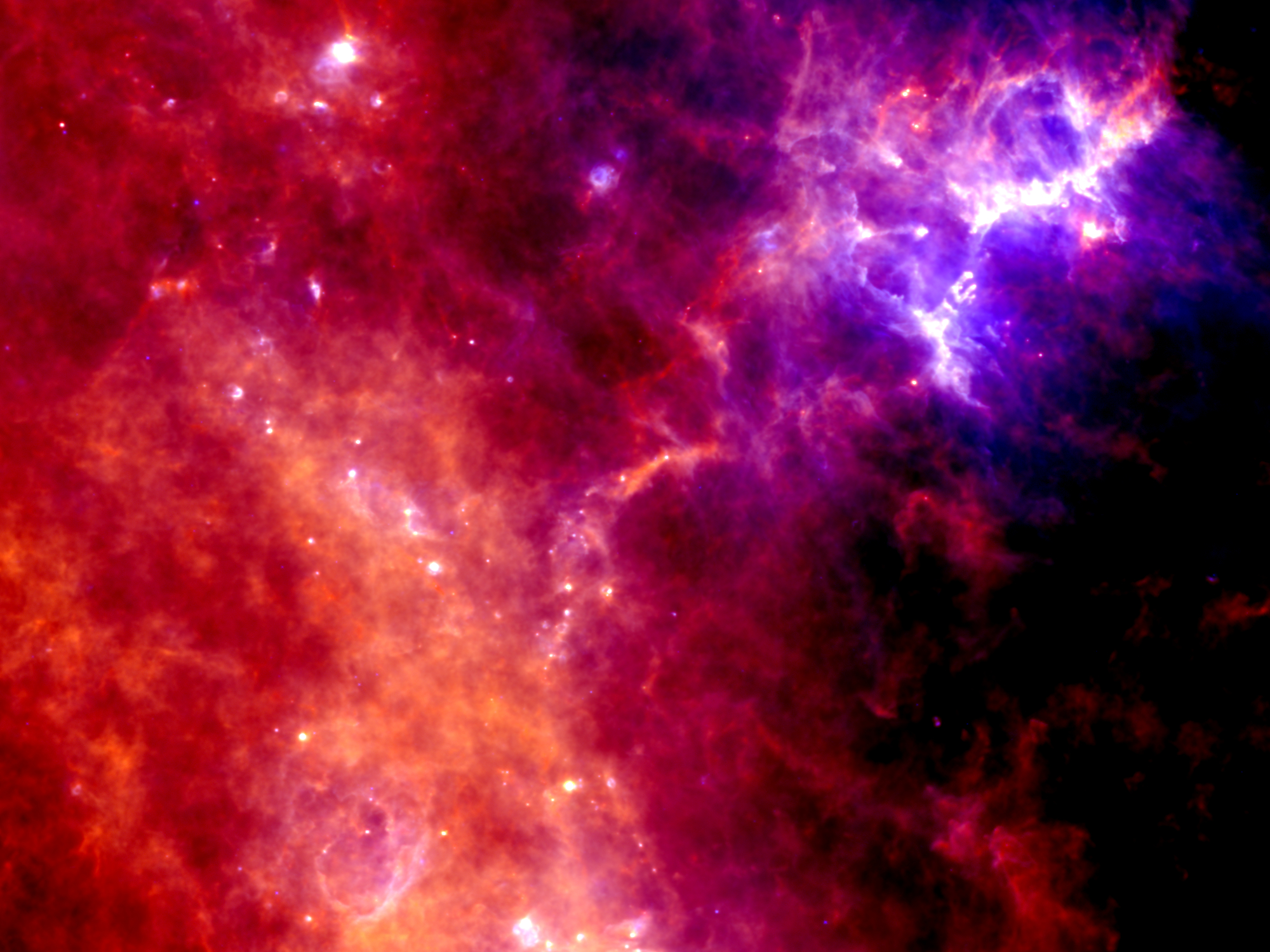

Eagle Nebula (M16)
Green: Herschel 160 micron far-infrared image of cold interstellar dust (FITS image)
Blue: Herschel 70 micron far-infrared image of warm interstellar dust (FITS image)
This image shows the variations in the infrared colours of the interstelar dust around M16 (in the upper right corner of the image) and the nearby galactic plane. M16 itself appears blue in this image because it contains substantial amounts of warm dust, which produces more emission at 70 microns relative to the emission from cool dust at 160 or 250 microns. Most of the galactic plane, however, appears red or yellow because the interstellar dust within the plane is generally cooler. As a side note, the "Pillars of Creation" made famous by the Hubble Space Telescope are visible near the bottom of M16.
All three of these images are based on archival data that I reprocessed.
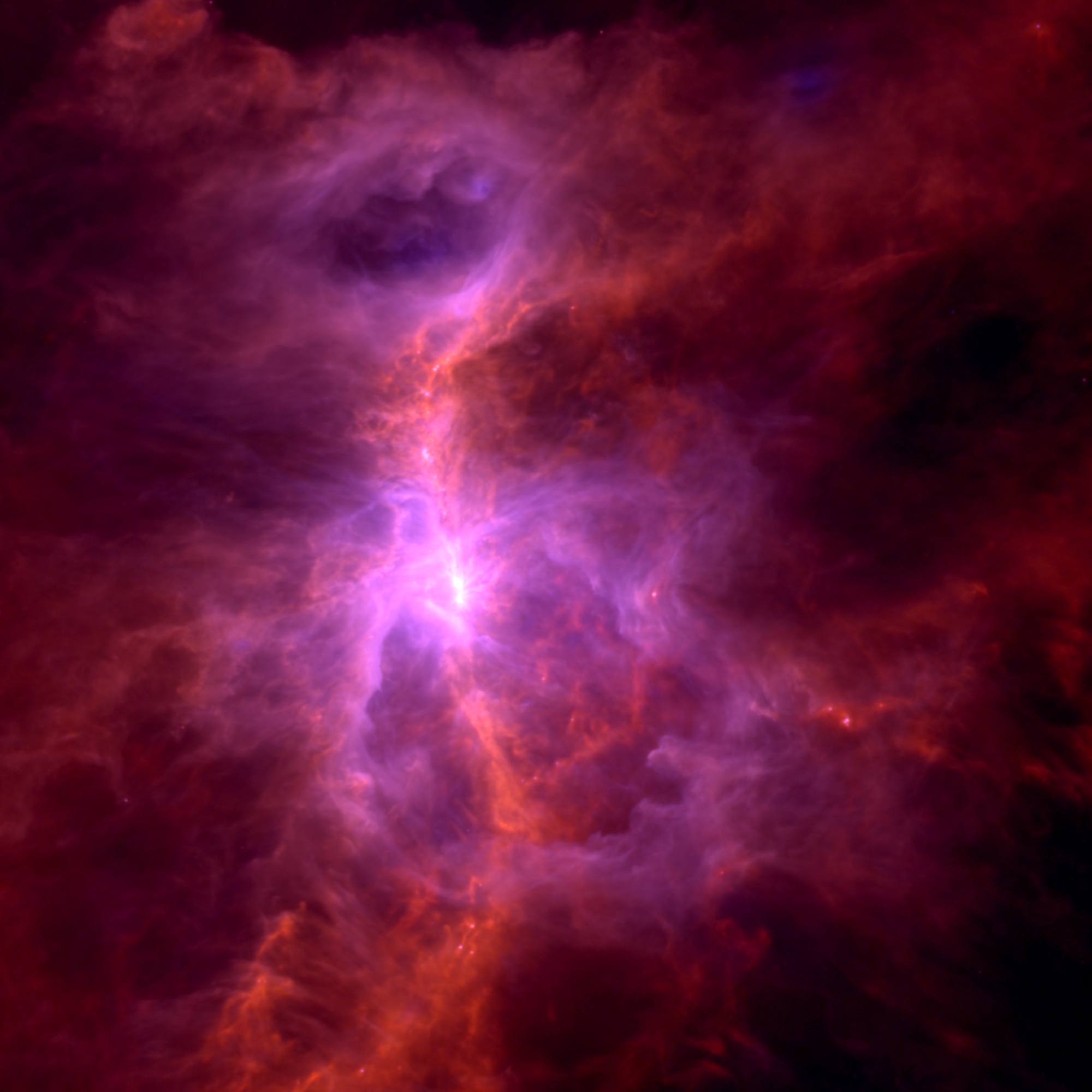
Orion Nebula (M42)
Green: Herschel 160 micron far-infrared image of cold interstellar dust (FITS image)
Blue: Herschel 70 micron far-infrared image of warm interstellar dust (FITS image)
This image shows the variations in the temperature of the interstellar dust around the Orion Nebula (the bright source to the left of the center of the image). The warmer dust appears purple, blue, or white in this image. This dust is heated by the hot young stars at the center of the star forming region as well as hot stars in a couple of other locations. Since the dust is very thick, the light from these stars will only travel a limited distance through the nebula. The dust that is not heated by the hot blue stars is colder and appears yellow or red in this image.
All three of these images are based on archival data that I reprocessed.
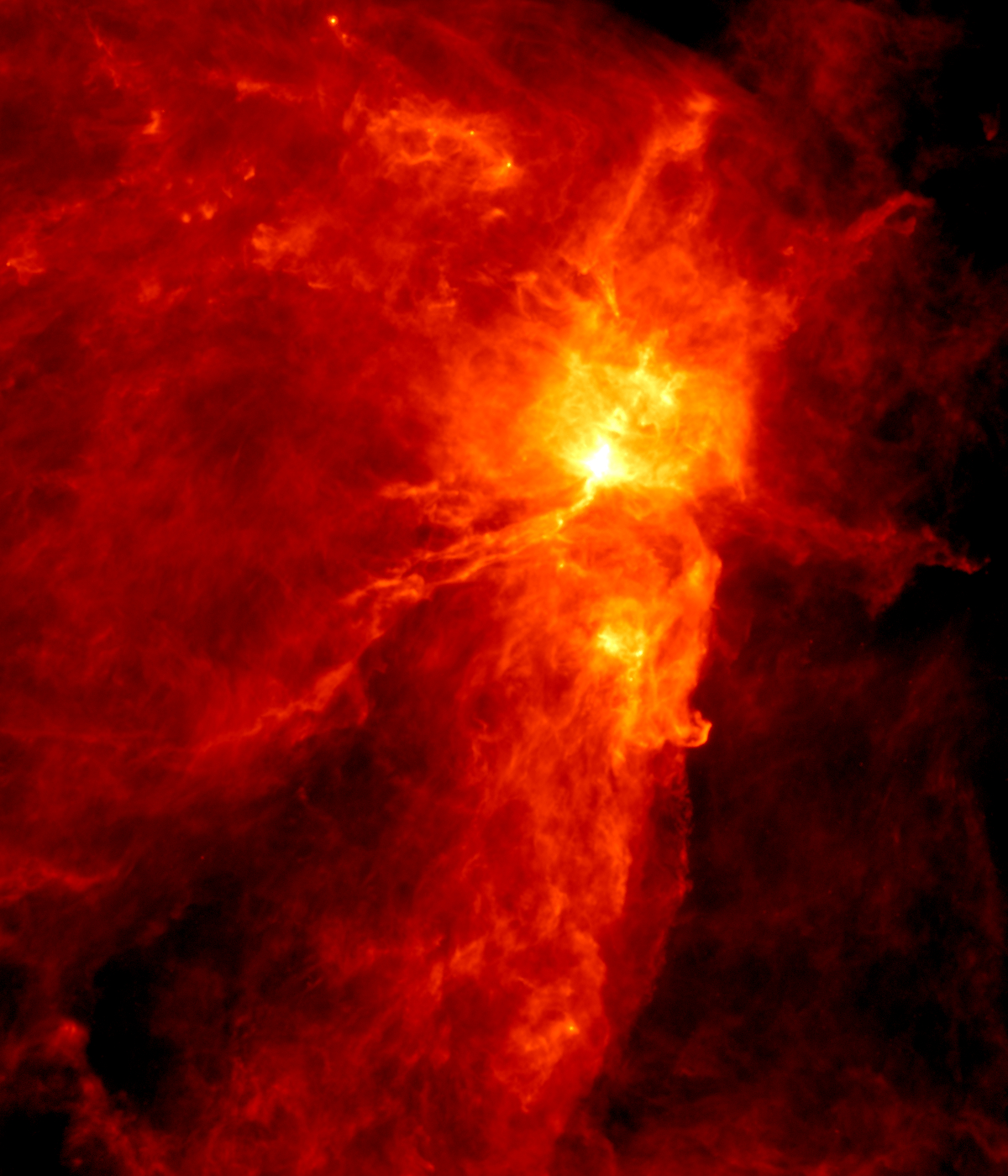
Orion B
Orion B is part of a large complex of star forming regions in the constellation of Orion. The brightest source in this image is also referred to as the Flame Nebula. The Horsehead Nebula is visible below it and slightly to the right. The Horsehead Nebula appears dark in visible light because the interstellar dust within it absorbs light from the nebula behind it, but that dust re-radiates that energy as infrared light and therefore looks bright in this infrared image.
This image is based on archival Herschel data that I reprocessed.
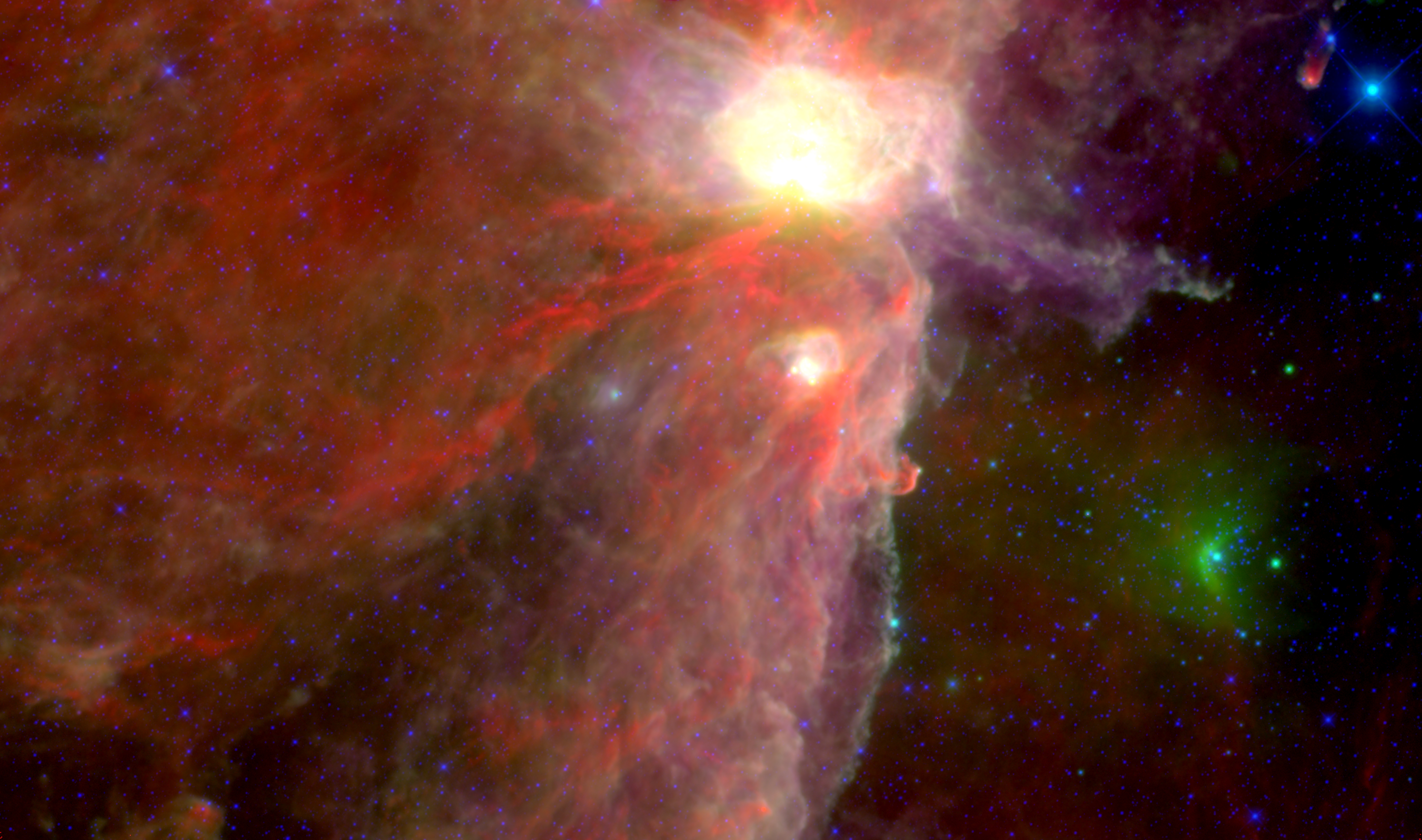

Orion B
Green: WISE 22 micron mid-infrared image of hot interstellar dust (FITS image)
Blue: WISE 3.4 micron near-infrared image of hot dust and old stars (FITS image)
This multicolor image shows how the cold insterstellar dust (which looks red in this image) appears more diffuse than the hot interstellar dust (which looks green, yellow, or white). The interior of the Horsehead Nebula in the center of the image looks red in this image because it contains a lot of cold dust, but the region around it has more hot dust and looks whiter. Also of interest is the green arc to the right, which is produced by hot dust heated by a bow shock in front of the star Sigma Orionis.
The far-infrared image is based on archival data that I reprocessed. The 3.4 and 22 micron images were downloaded in pipeline-processed form from the WISE archive; I then mosaicked several panels together to create the green and blue channels. Because of defects in the WISE images, I created a jpg that was a different size than the 250 micron false-color image.
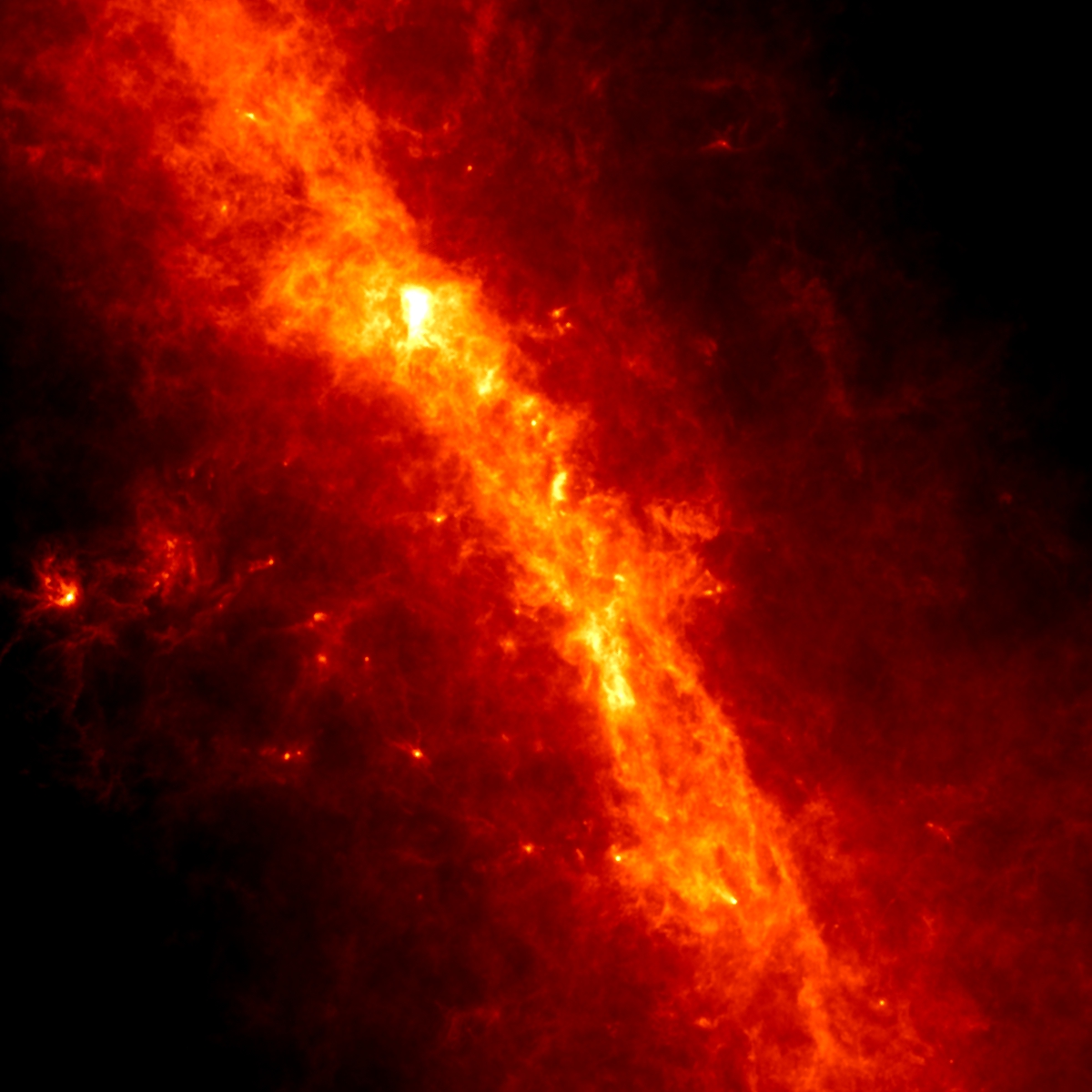
Sgr A* and Sgr B2
The center of the Milky Way Galaxy lies in the constellation Sagittarius. Since the disk of the galaxy contains most of the galaxy's interstellar gas and dust, we see large amounts of infrared emission from this dust in Sagittarius. This image contains two particularly important objects. The brightest object is Sgr B2, a star forming region that is one of the infrared brightest sources in the sky. Slightly below and to the right of the center is Sgr A*, the supermassive black hole at the center of the galaxy.
This is a newer version of the image that I published for my paper on the flux calibration of the Herschel-SPIRE instrument (Bendo et al. 2013, MNRAS, 433, 3062).
Planetary Nebulae and Supernova Remnants
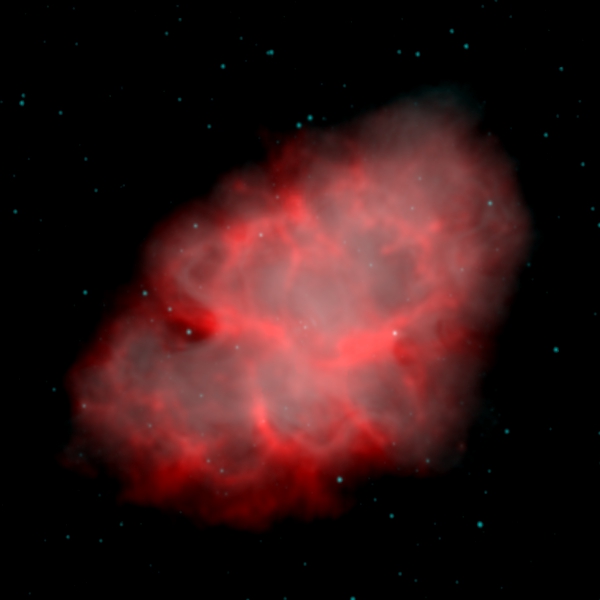
Crab Nebula (M1; NGC 1952)
Cyan: Spitzer 3.6 micron near-infrared image of synchrotron emission (FITS image)
The Crab Nebula is the remnant of a supernova that exploded in 1054. The emission seen in many parts of the electromagnetic spectrum, including the near-infrared (shown as cyan), is synchrotron emission. This form of emission comes from electrons oscillating around magnetic fields in space. The mid-infrared emission (shown in red) comes from dust formed in the supernova.
I created these image using data from the Spitzer archives.
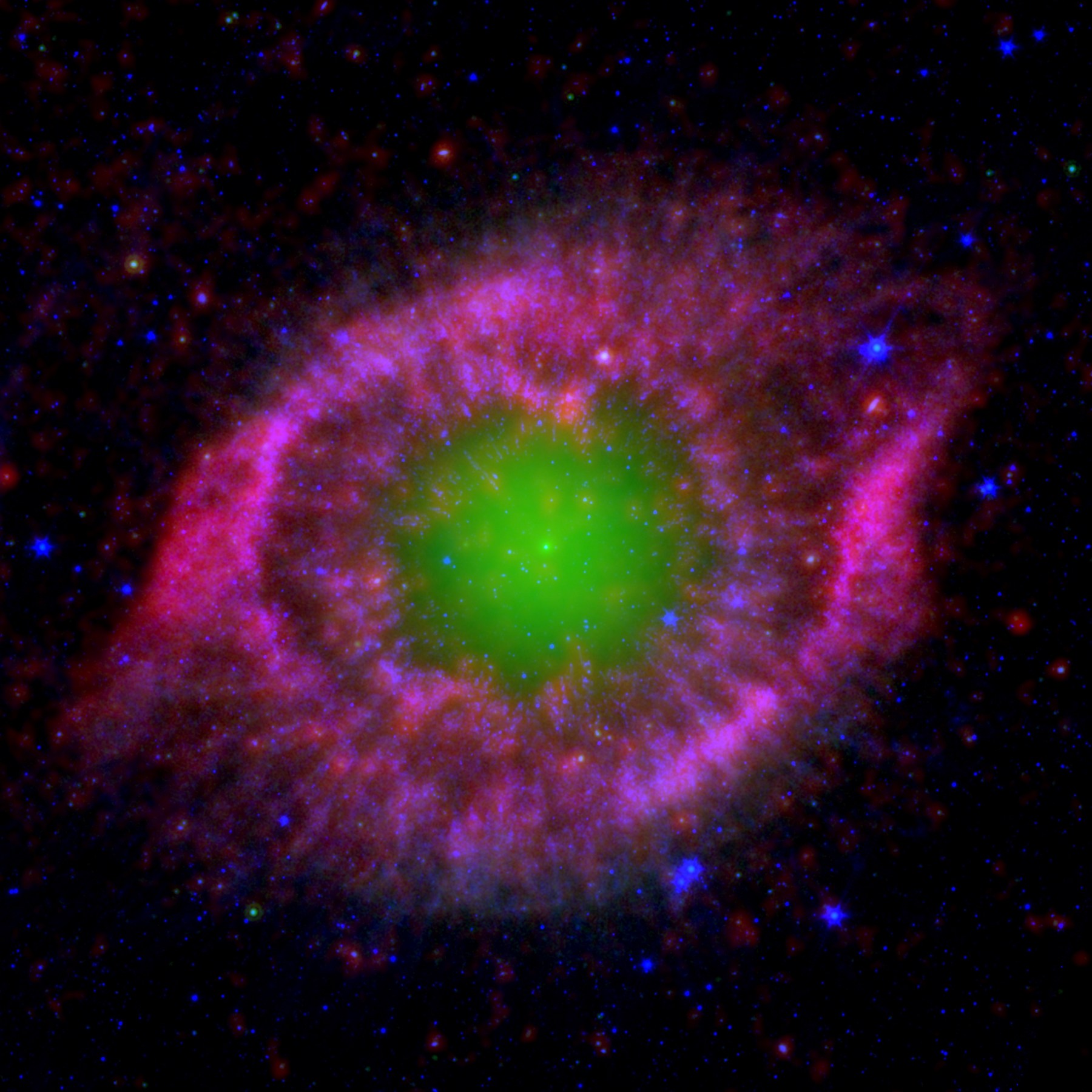
Helix Nebula (NGC 7293)
Green: Spitzer 24 micron mid-infrared image of ionized gas (FITS image)
Blue: Spitzer 3.6 micron near-infrared image of hot dust (FITS image)
The Helix Nebula and other planetary nebulae like it eject a lot of dust into the interstellar medium. What is somehwat unusual about the mid-infrared emission from planetary nebulae near a wavelength of 24 microns is that it originates mainly from ionized oxygen. In most other objects, mid-infrared emission at this wavelength would originate from hot interstellar or circumstellar dust.
I created all of these images from data in the Spitzer and Herschel archives.
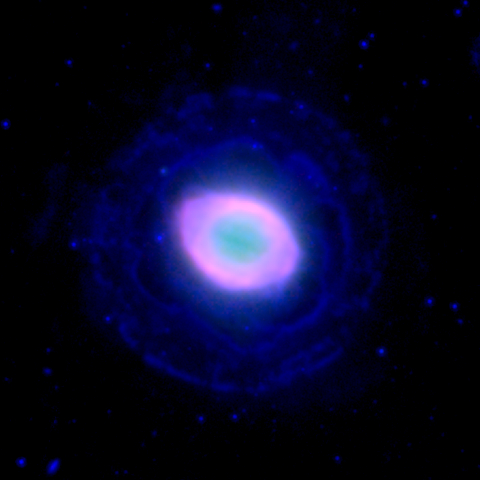
Ring Nebula (M57; NGC 6720)
Green: Spitzer 24 micron mid-infrared image of ionized gas (FITS image)
Blue: Spitzer 8 micron mid-infrared image of hot dust (FITS image)
The Ring Nebula is one of the best known planetary nebulae. The object looks very much like a single ring in visible wavelengths, but the mid-infrared observations by Spitzer detected a more extended structure of dust (including polycyclic aromatic hydrocarbon molecules) surrounding the nebula. Ionized oxygen in this nebula produces emission near 24 microns, which is why the center of the ring appears green in this image.
I created all of these images for this webpage using data from the Spitzer and Herschel archives. Note that the JWST has made more detailed mid-infrared images.
Galaxies
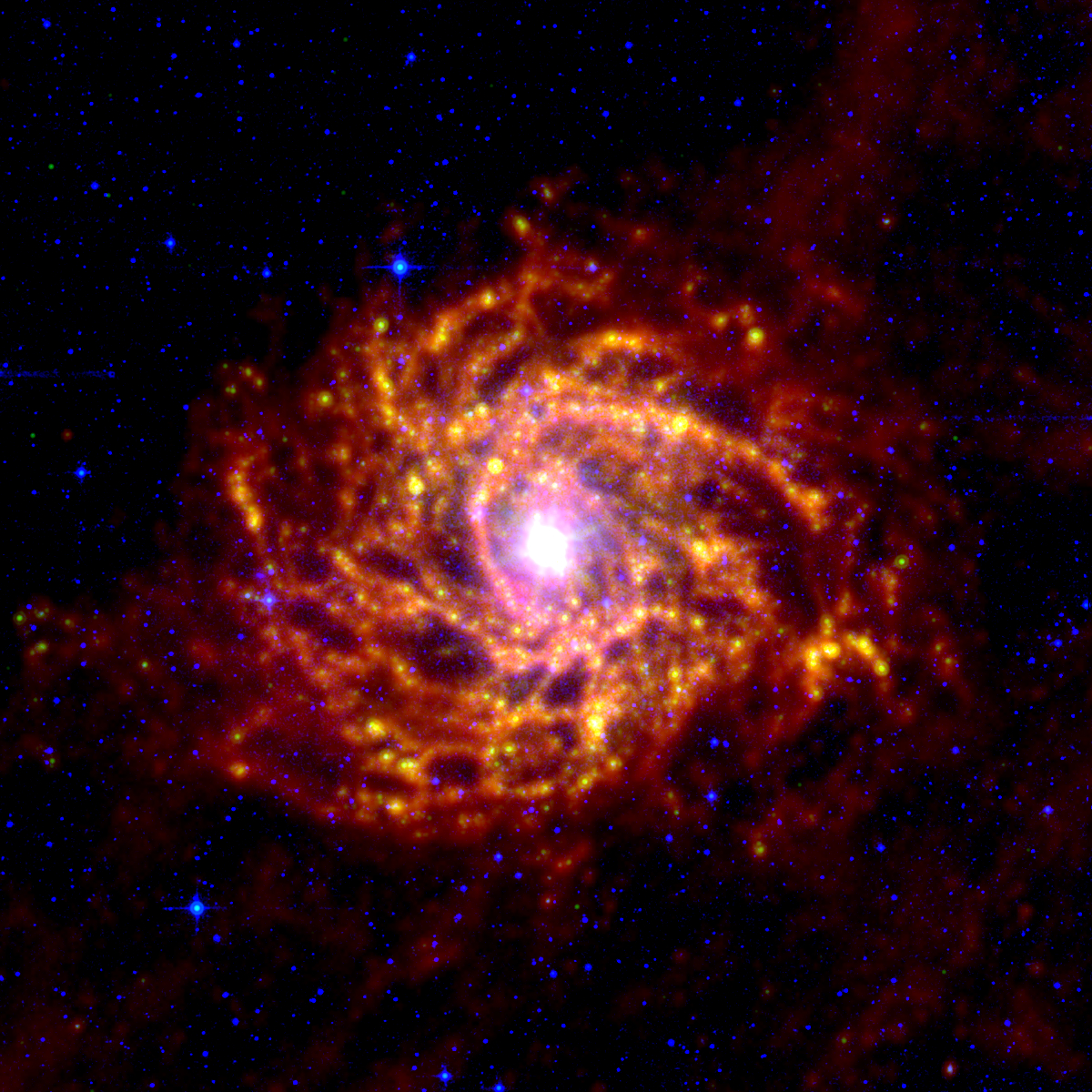
IC 342
Green: Spitzer 24 micron mid-infrared image of hot interstellar dust (FITS image)
Blue: 2MASS 2.2 micron near-infrared image of old stars (FITS image)
IC 342 is a nearby spiral galaxy that would be much more famous if it did not appear in the plane of the Milky Way as seen from the Earth. The interstellar dust in the Milky Way tends to obscure the ultraviolet and visible light from the galaxy, but the infrared light passes through this dust more easily. While the interstellar dust in IC 342 can be seen in the mid- and far-infrared emission, some interstellar dust in the Milky Way also appears as filamentary far-infrared emission elsewhere in the image.
I created the mid- and far-infrared images myself. The near-infrared image is from the 2MASS Large Galaxy Atlas (Jarrett T. H. et al., 2003, AJ, 125, 525).
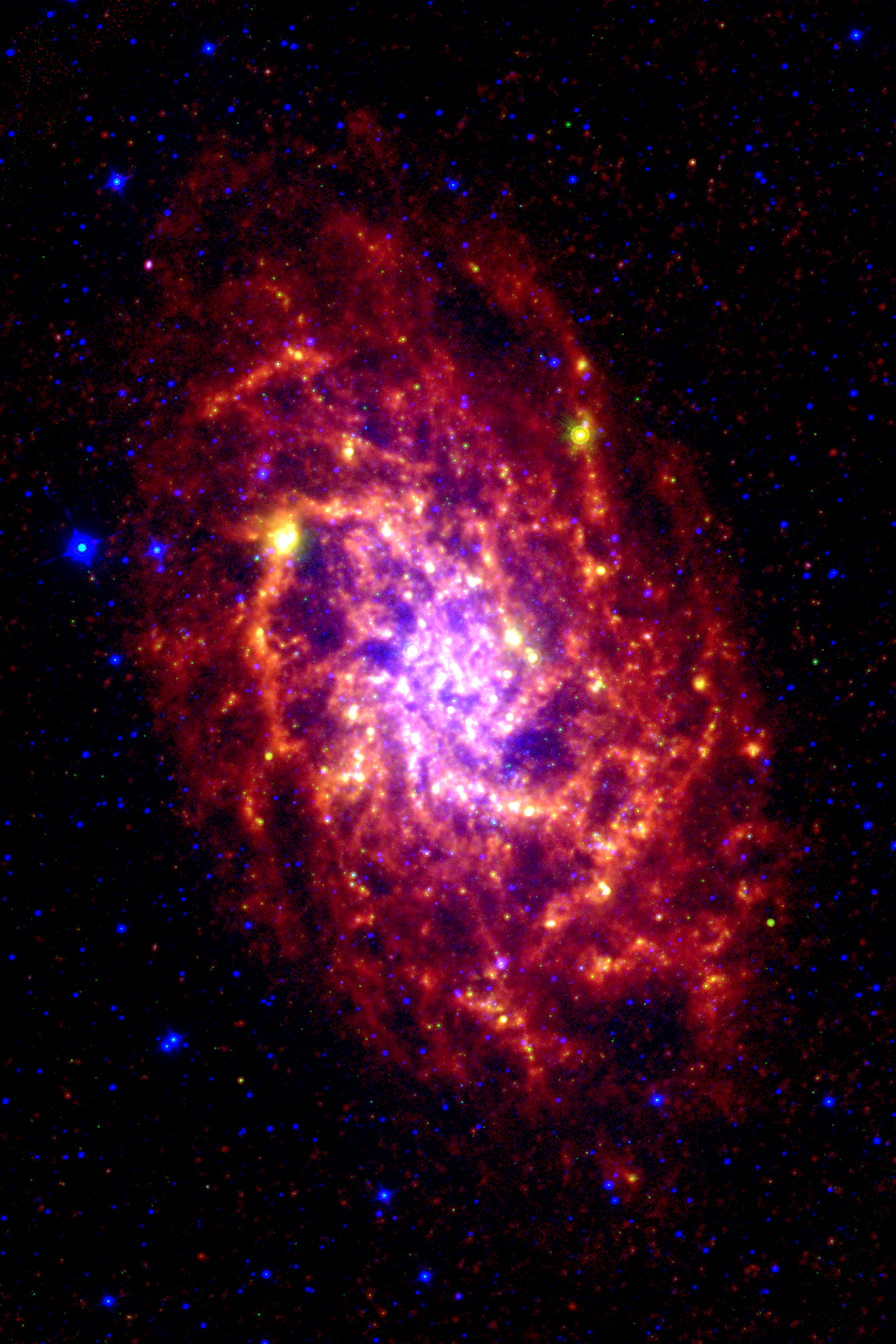
M33 (NGC 598)
Green: Spitzer 24 micron mid-infrared image of hot interstellar dust (FITS image)
Blue: WISE 3.4 micron near-infrared image of old stars (FITS image)
M33 is the third largest galaxy in the Local Group. The places where stars are forming (as traced by the mid-infrared emission from hot dust) appears in multiple knots within the filamentary spiral arms. The colder dust seen in the far-infrared is heated by the ambient light from the older stars and appears more extended and filamentary.
The 24 and 250 micron images are based on archival data that I reprocessed. The 3.4 micron image is based on multiple smaller pipeline-processed WISE images that I downloaded and combined together to form a larger mosaic.
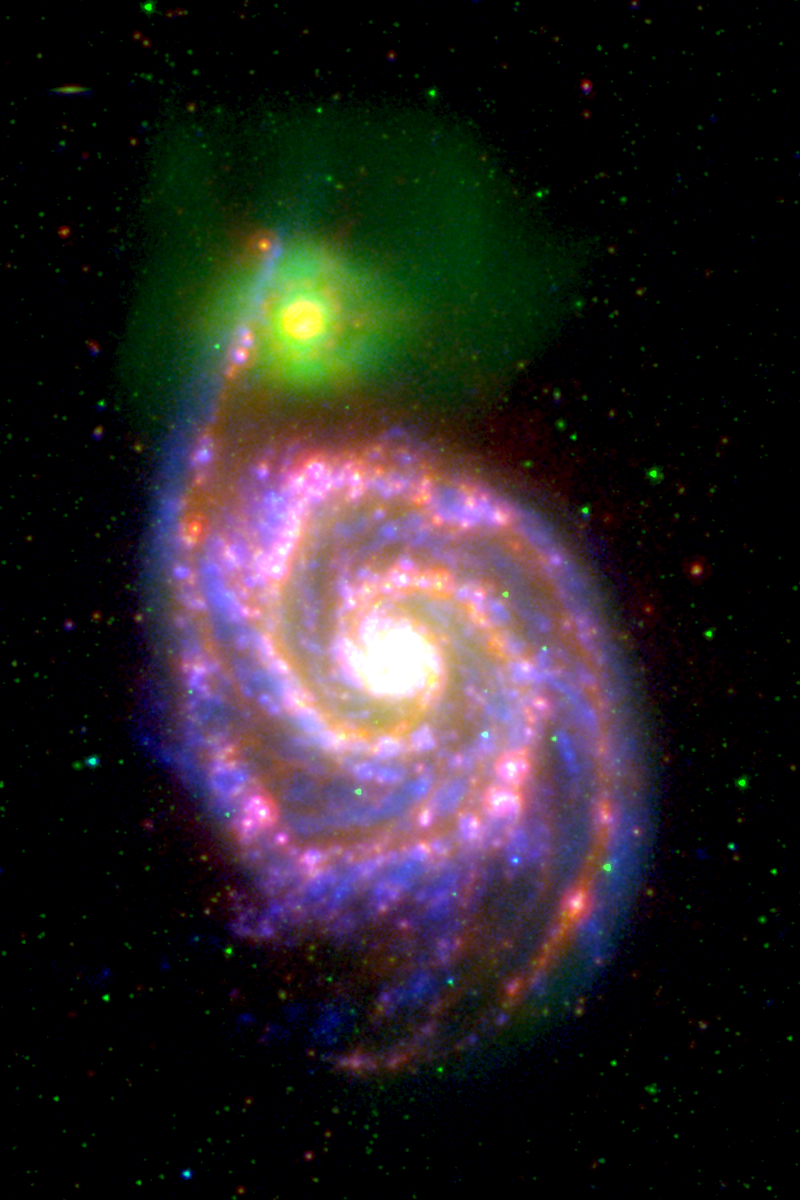
M51 (NGC 5194/5195)
Green: Spitzer 3.6 micron near-infrared image of older stars (FITS image)
Blue: GALEX 2267 Angstrom ultraviolet image of young stars (FITS image)
M51 is a famous pair of galaxies where a large spiral galaxy is gravitationally interacting with a smaller spheroidal galaxy. The mid-infrared image shows the hot dust surrounding the regions where stars are forming, while the ultraviolet image shows that those stars have migrated out of the spiral arms. The spheroidal galaxy does not contain much star formation (except in its nucleus) and therefore appears green in this image.
The 24 micron image is a version that I published (Bendo et al., 2012, MNRAS, 423, 197). I created the 3.6 micron image from archival data, although other versions are also available. The ultraviolet image is from the GALEX archive.
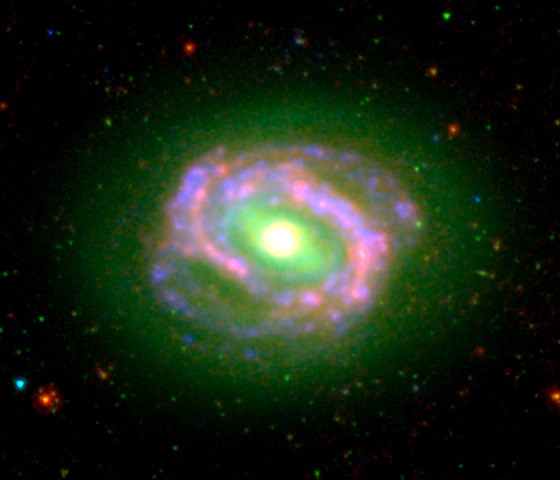

M58 (NGC 4579)
Green: Spitzer 3.6 micron near-infrared image of older stars (FITS image)
Blue: GALEX 2267 Angstrom ultraviolet image of young stars (FITS image)
M58 (NGC 4579) is one of many Virgo Cluster galaxies that appears in the Messier catalog. The ultraviolet emission shown in blue and the mid-infrared emission shown in red both trace star forming regions in the spiral arms very nicely. The near-infrared emission displayed in green traces the older stars in this galaxy and shows that the older stars appear more extended than the star forming regions.
The 24 micron image is a version that I published (Bendo et al., 2012, MNRAS, 423, 197). I created the 3.6 micron image from archival data. The ultraviolet image is from the GALEX archive.
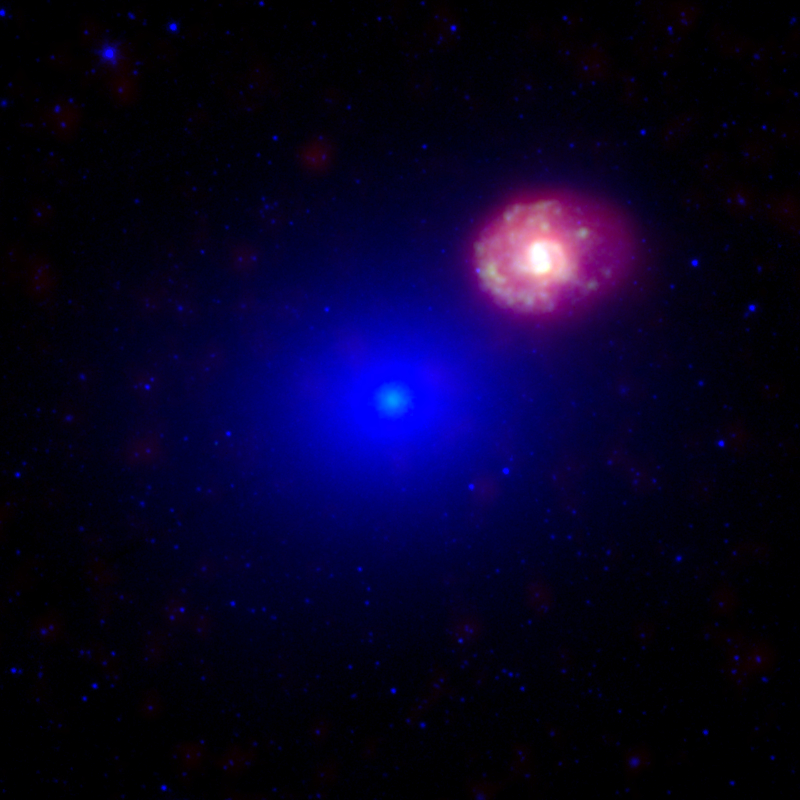
M60 (NGC 4647/4649)
Green: Spitzer 24 micron mid-infrared image of hot interstellar dust (FITS image)
Blue: Spitzer 3.6 micron near-infrared image of older stars ( FITS image)
M60 consists of a pair of galaxies. The larger galaxy in the center is NGC 4649, which is one of the larger elliptical galaxies in the Virgo Cluster. The smaller galaxy in the upper right is a distorted-looking spiral galaxy named NGC 4647. It is unclear whether the two galaxies are actually close enough to be interacting or if they just happen to fall along the same line of sight.
This image shows the dramatic difference in the dust content between the two galaxies. The spiral galaxy contains a substantial amount of dust and cold gas that is being turned into stars in places where the mid-infrared emission appears bright (yellow and white locations in this image). The elliptical galaxy contains virtually no dust and therefore produces no emission in the far-infrared. The only mid-infrared emission from the elliptical galaxy is actually produced from stars near the center that are so densely packed together that the mid-infrared emission, which is relatively weak for individual stars but much larger when many stars are combined together, can actually be detected.
The 24 micron image is a version that I published (Bendo et al., 2012, MNRAS, 423, 197). I created the 3.6 micron image from archival data. The ultraviolet image is from the GALEX archive.
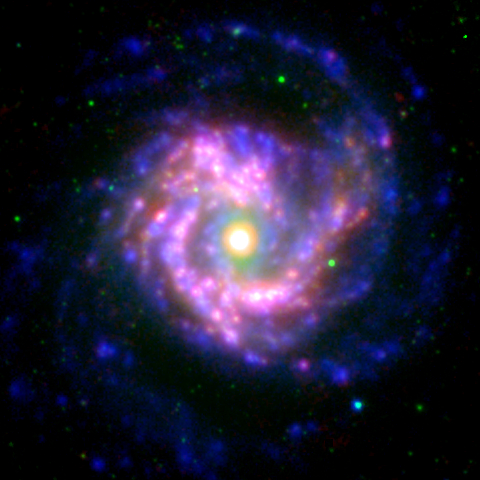
M61 (NGC 4303)
Green: Spitzer 3.6 micron near-infrared image of older stars (FITS image)
Blue: GALEX 2267 Angstrom ultraviolet image of young stars (FITS image)
M61 is one of many spiral galaxies within the Virgo Cluster. The galaxy is a little unusual among spiral galaxies in that it has three spiral arms that are faintly visible in the ultraviolet image. Many other Virgo Cluster galaxies have been affected by interactions between the gas within the galaxies' disks and the intracluster gas, which generally removes the gas from the galaxies' outer disks, but M61 is sufficiently distant from the center than it has not been affected this way yet.
The 24 micron image is a version that I published (Bendo et al., 2012, MNRAS, 423, 197). I also created the 3.6 micron image. The ultraviolet image is from the GALEX archive.
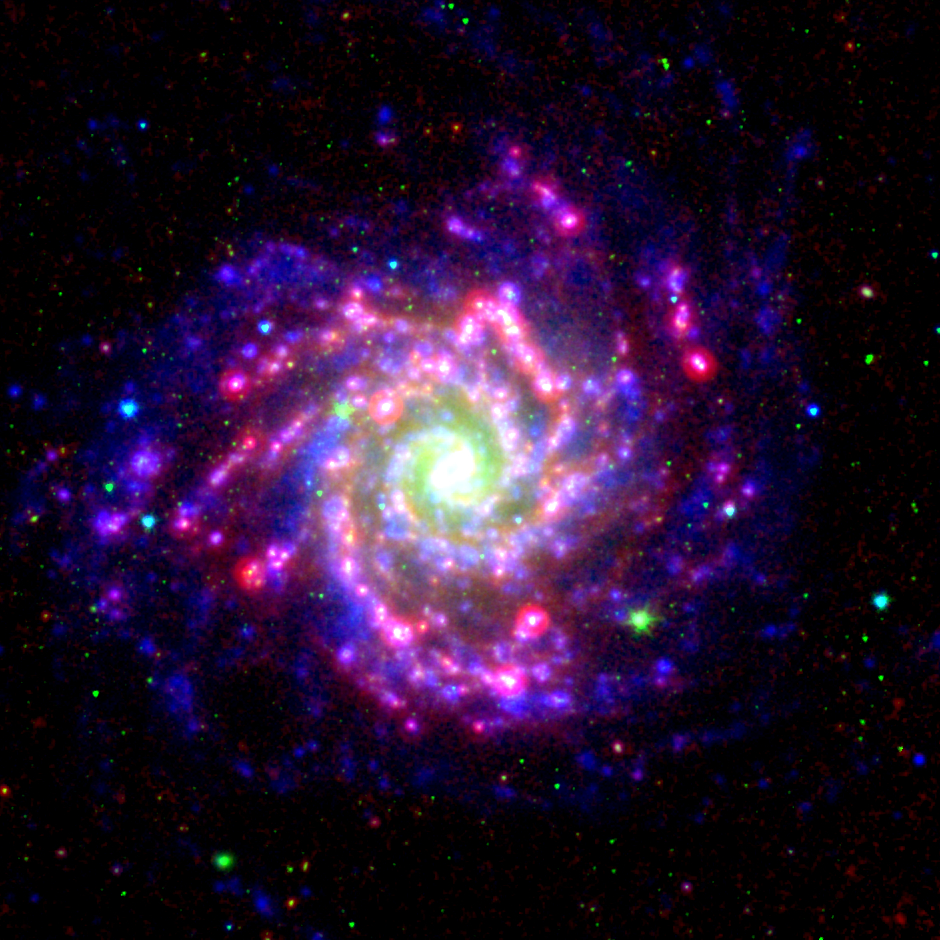
M74 (NGC 628)
Green: Spitzer 3.6 micron near-infrared image of older stars (FITS image)
Blue: GALEX 2267 Angstrom ultraviolet image of young stars (FITS image)
M74 is another well-known spiral galaxy seen face-on. The ultraviolet and infrared light both originate mainly from regions with young stars found within the spiral arms, but the outskirts of the galaxy tend to contain less dust and therefore produce more ultraviolet light compared to infrared light.
I recreated the 24 micron image myself for this image. I created the 3.6 micron image for a science paper (Bendo et al., 2020, MNRAS, 496, 1393). The ultraviolet image is from the GALEX archive. The JWST has also published mid-infrared images that show more detail than mine, at least in the center of the galaxy.
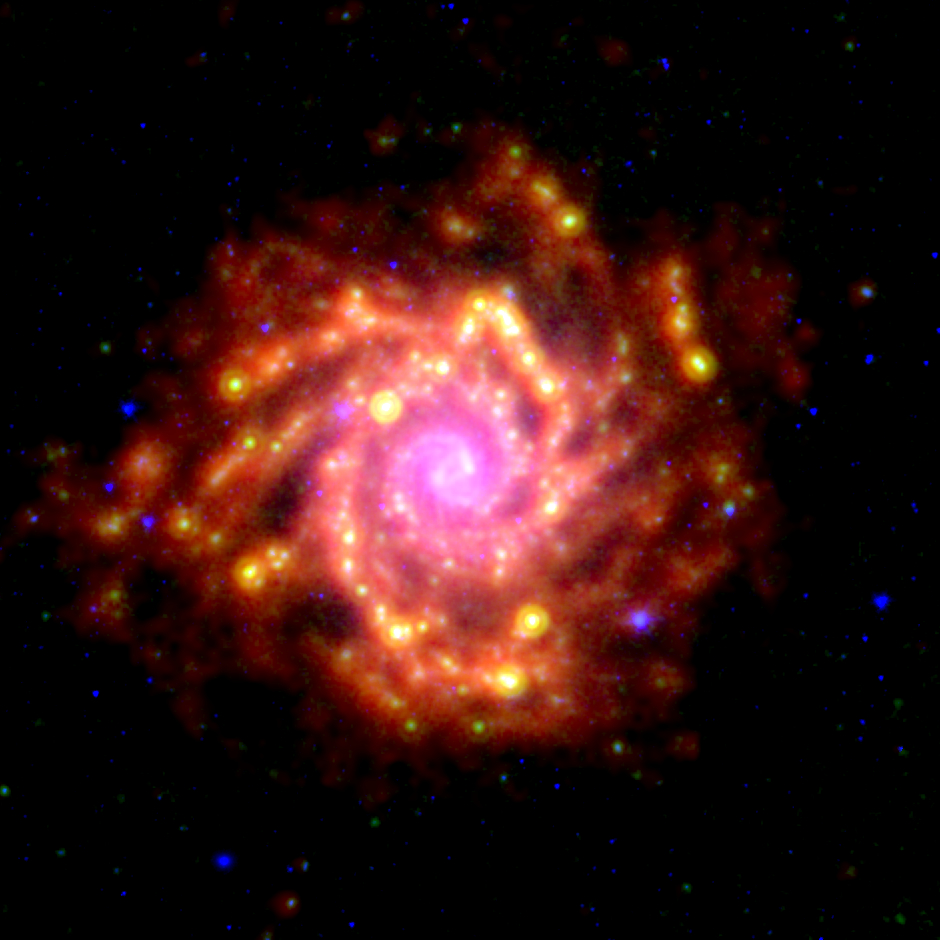
M74 (NGC 628)
Green: Spitzer 24 micron mid-infrared image of hot interstellar dust (FITS image)
Blue: Spitzer 3.6 micron near-infrared image of older stars (FITS image)
Although the Herschel 250 micron image appears more blurry than the Spitzer 24 micron image, this image still shows that the interstellar dust in star forming regions within the spiral arms tends to be hotter than the dust either in the spiral arms between these regions or in the interarm regions.
I recreated the 24 micron image myself for this image and the one above. I created the other images for a science paper (Bendo et al., 2020, MNRAS, 496, 1393). The JWST has also published mid-infrared images that show more detail than mine, at least in the center of the galaxy, although I anticipate that the far-infrared image may be the best image that could be created during the course of my career.
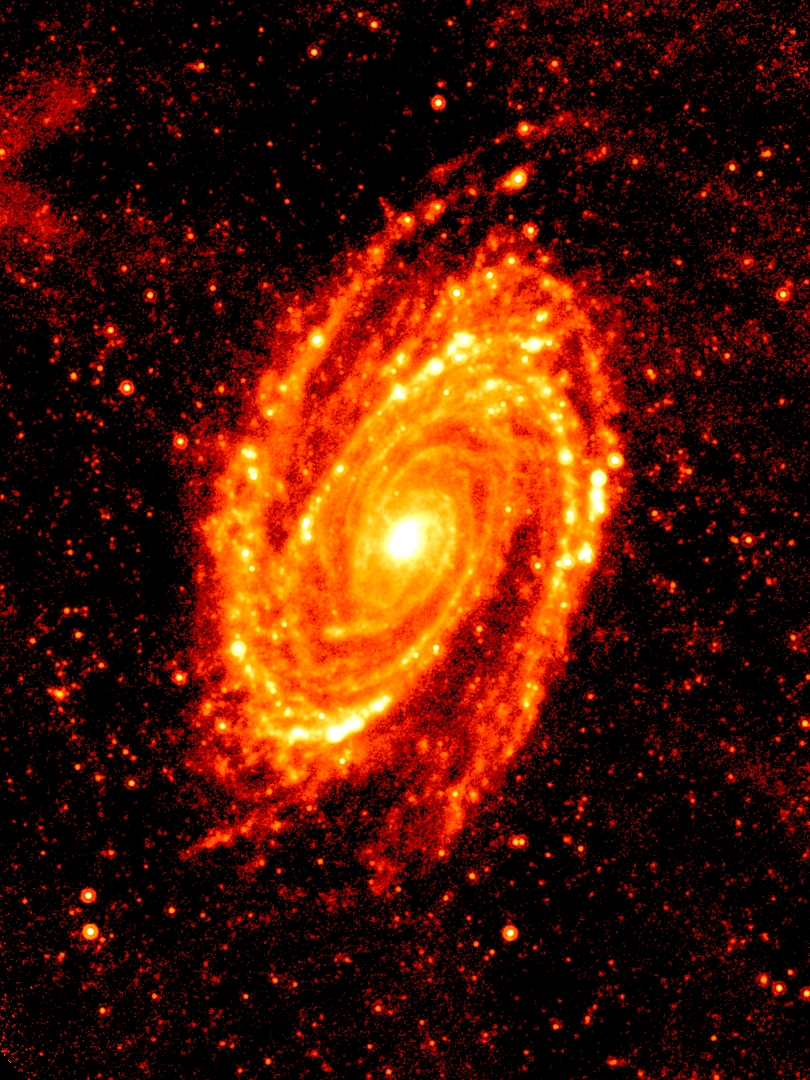
M81 (NGC 3031
M81 is the largest galaxy in the M81 Group, one of the closest galaxy groups to our group of galaxies, the Local Group. The mid-infrared emission from interstellar dust traces star formation in the outer spiral arms, but I have used the emission in the center as an example of emission from dust heated by the older bulge stars.
This image is a version that I published (Bendo et al., 2012, MNRAS, 423, 197). I also used a variant of this image in the header on my webpages for a while.
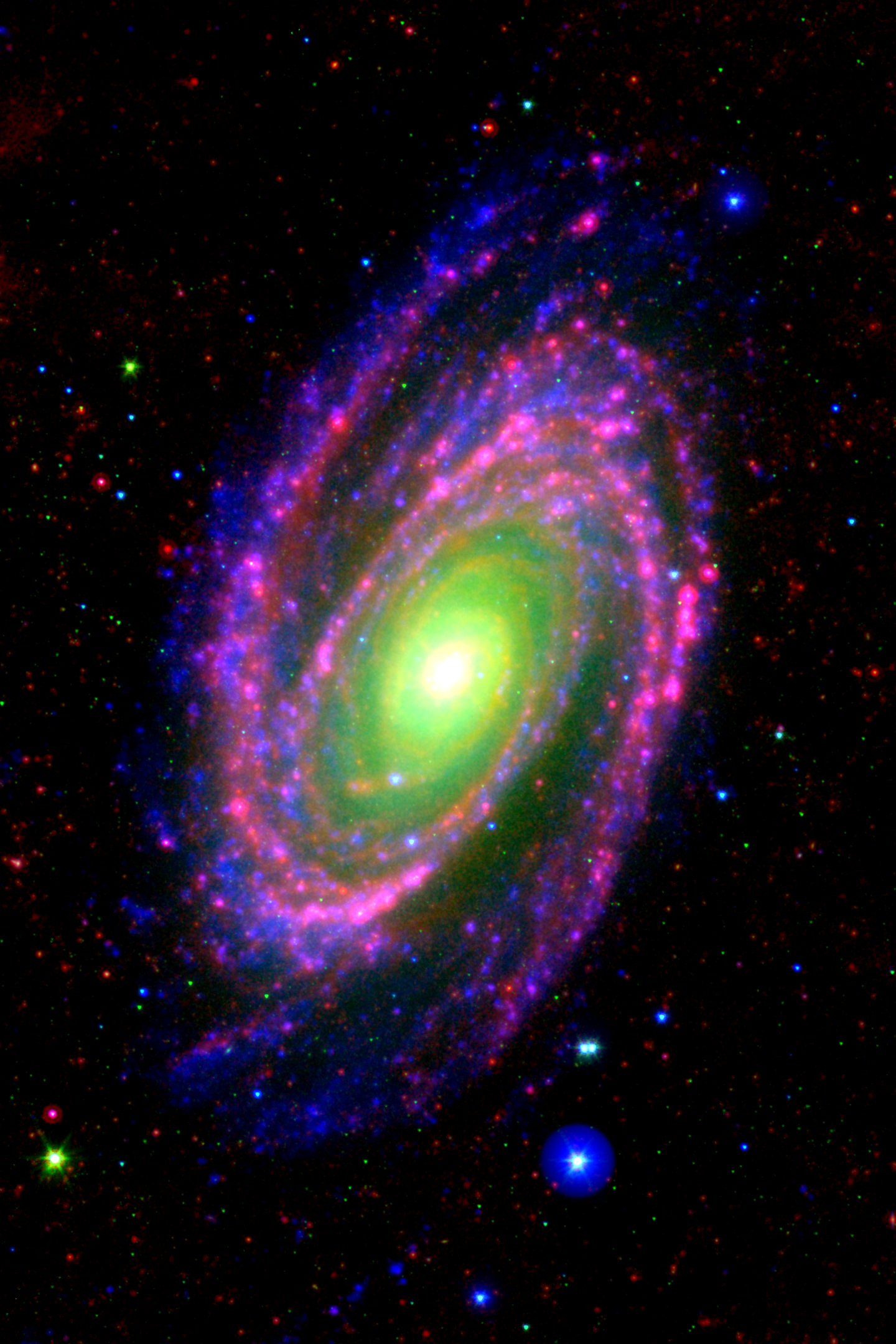
M81 (NGC 3031
Green: Spitzer 3.6 micron near-infrared image of older stars (FITS image)
Blue: GALEX 2267 Angstrom ultraviolet image of young stars (FITS image)
This image shows ultraviolet and mid-infrared emission together, both of which trace star formation. The ultraviolet emission traces unobscured young stars, while the mid-infrared emission traces mainly dust heated by obscured young stars (although the dust could also be heated by older stars). The spiral arms themselves tend to look magenta because the young stars are partially obscured, although the edges of the spiral arms may look blue because some of the young stars have migrated away from the dust clouds in which they formed. The 24 micron image is the version that I published (Bendo et al., 2012, MNRAS, 423, 197). The 3.6 micron image is one that I created. The ultraviolet image is from the GALEX archive.
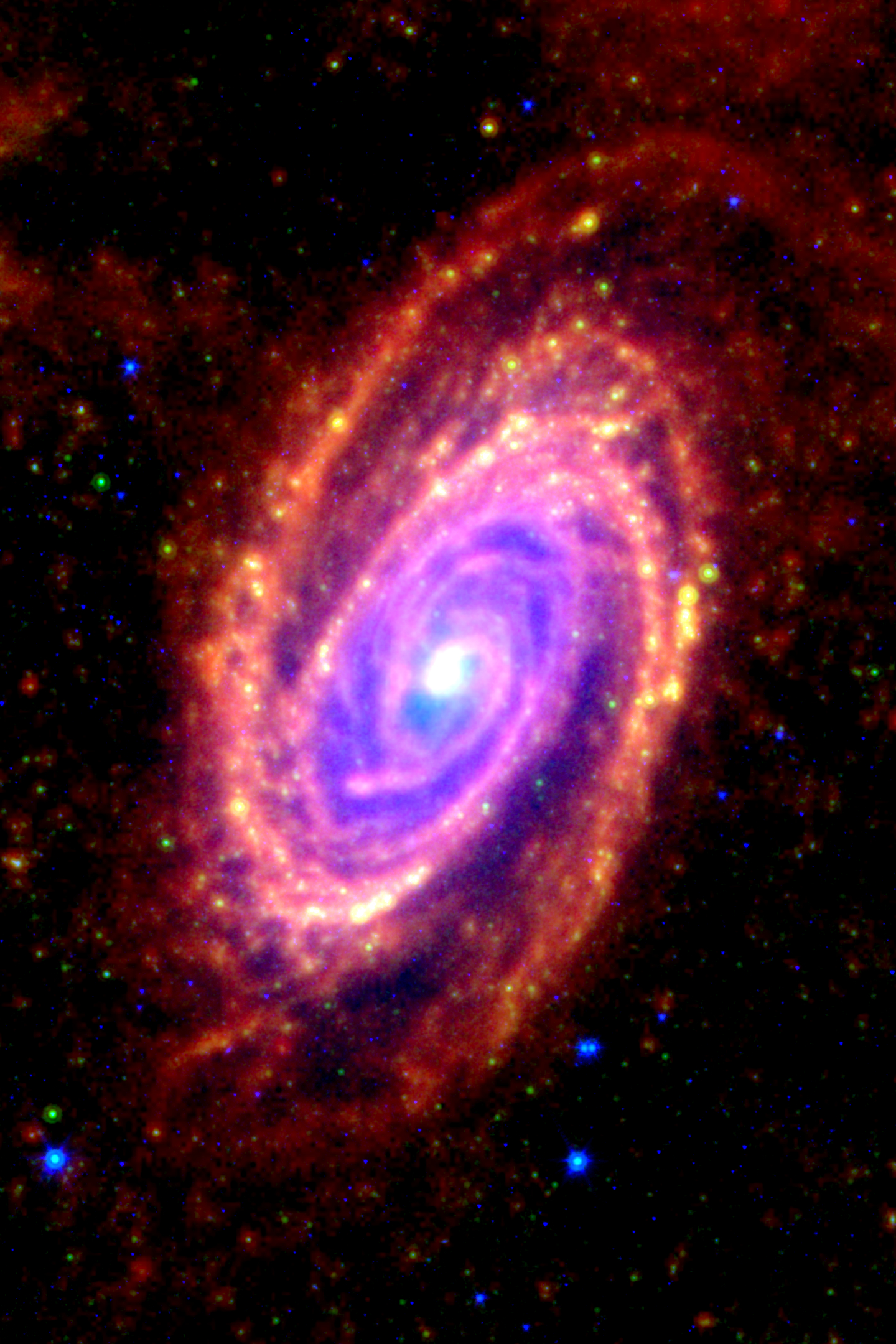
M81 (NGC 3031
Green: Spitzer 24 micron mid-infrared image of hot interstellar dust (FITS image)
Blue: Spitzer 3.6 micron near-infrared image of older stars (FITS image)
This image, which shows both the hot and cold interstellar dust in M81 illustrated how the dust emission varies within the galaxy. The hot dust emission is more prominent in individual locations within the spiral arms where stars are forming, while the colder dust is more prominent in the diffuse regions between these star forming regions as well as in the center of the galaxy.
The 24 micron image is the version that I published (Bendo et al., 2012, MNRAS, 423, 197). The 3.6 and 250 micron images are also my creations. I also use this image in the header on my webpages.
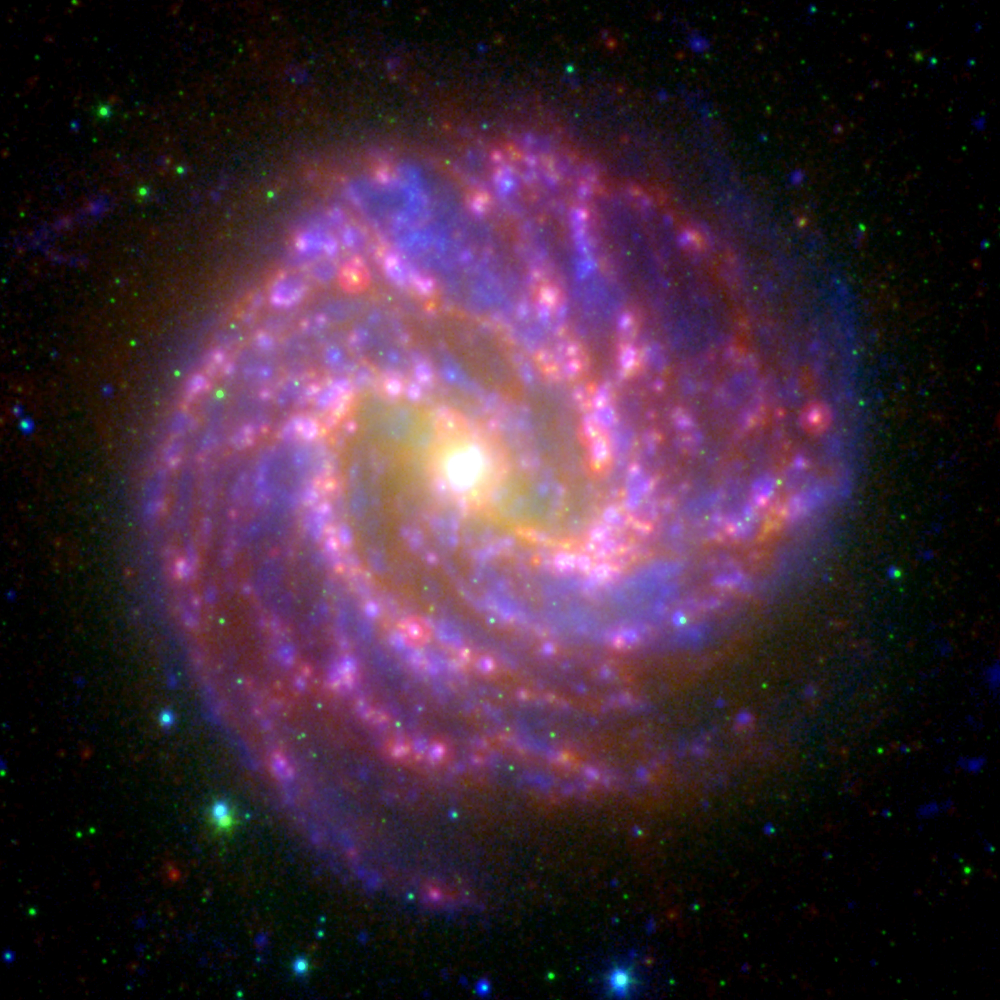
M83 (NGC 5236)
Green: Spitzer 3.6 micron near-infrared image of older stars (FITS image)
Blue: GALEX 2267 Angstrom ultraviolet image of young stars (FITS image)
M83, along with M51, is one of the two most prominent examples of spiral galaxies containing spiral density waves. As is also the case for M51, the mid-infrared image of M83 shows the dusty regions where stars are forming, while the ultraviolet image shows that the newly-formed stars have moved out of the spiral arms from where they formed.
The 24 micron image is a version that I published (Bendo et al., 2012, MNRAS, 423, 197). The 3.6 micron image is a version that I created from archival data. The ultraviolet image is from the GALEX Ultraviolet Atlas of Nearby Galaxies (Gil de Paz et al., 2007, ApJS, 173, 185).
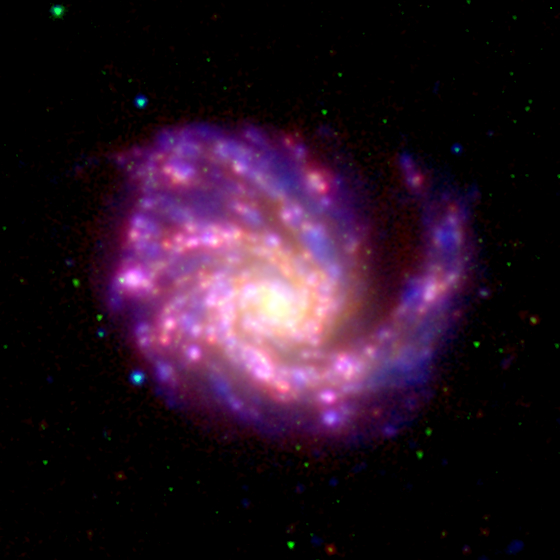
M99 (NGC 4254)
Green: Spitzer 3.6 micron near-infrared image of older stars ( FITS image)
Blue: GALEX 2267 Angstrom ultraviolet image of young stars ( FITS image)
M99 is one of the brighter spiral galaxies in the Virgo Cluster. It also looks noably asymmetric. An offset is visible between the ultraviolet and infrared light in some parts of the spiral arms, particularly the elongated arm on the right, but the offsets are not as distinct as in M51 or M83.
The 24 micron image is a version that I published (Bendo et al., 2012, MNRAS, 423, 197). I created the 3.6 micron image. The ultraviolet image is from the GALEX archive.
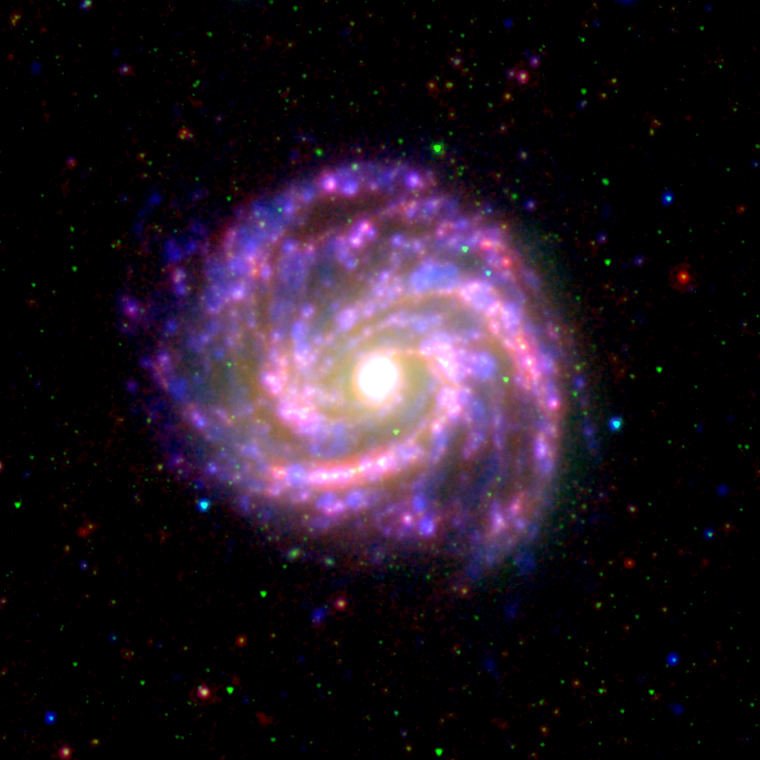
M100 (NGC 4321)
Green: Spitzer 3.6 micron near-infrared image of older stars ( FITS image)
Blue: GALEX 2267 Angstrom ultraviolet image of young stars ( FITS image)
M100 is another bright spiral galaxies in the Virgo Cluster. Interestingly, the ultraviolet light does not appear offset from the infrared light in the spiral arms as it does in the grand design spiral galaxies M51 and M83, although this could be in part because M100 is further away and therefore any offset would be less apparent.
The 24 micron image is a version that I published (Bendo et al., 2012, MNRAS, 423, 197). I created the 3.6 micron image myself. The ultraviolet image is from the GALEX archive.
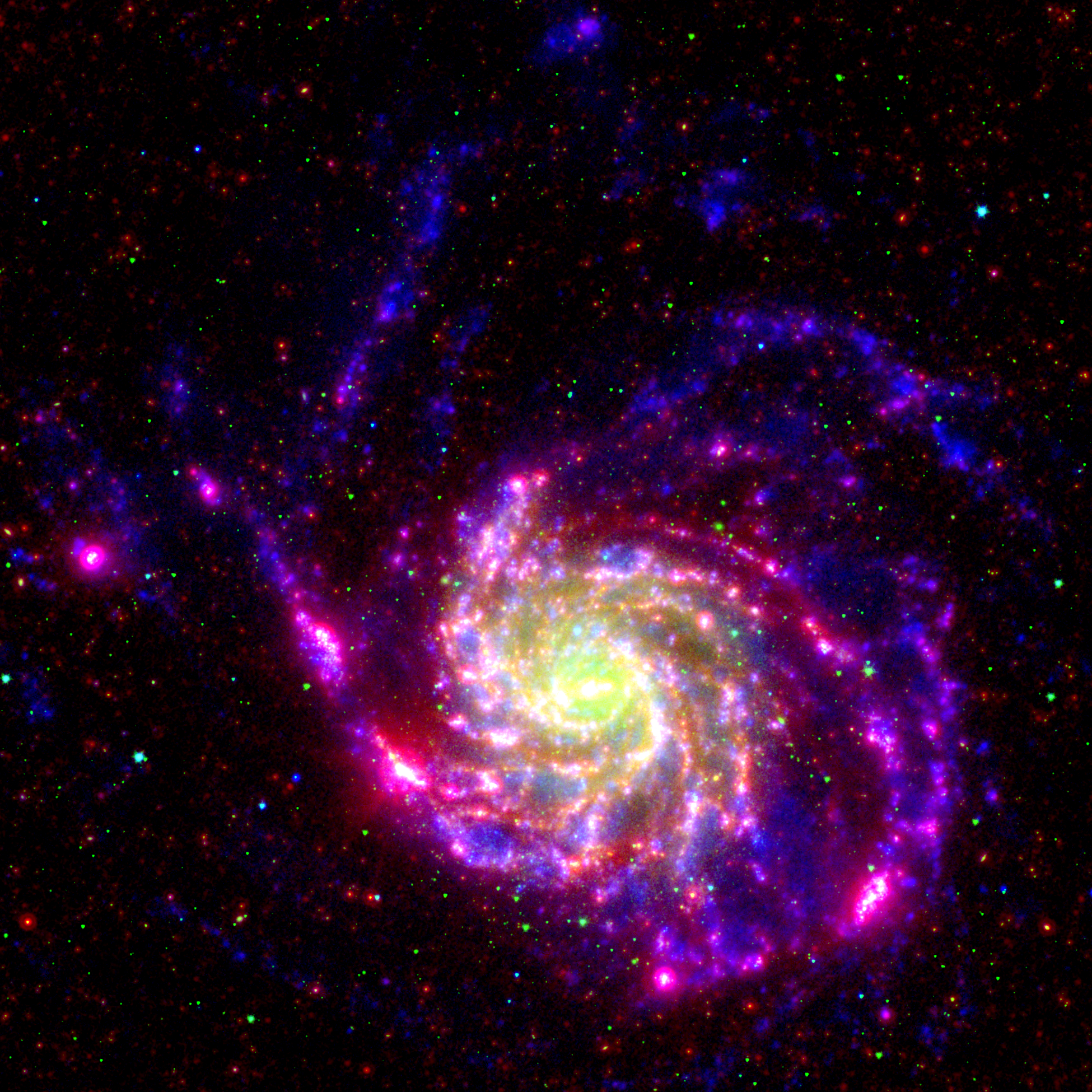
M101 (NGC 5457)
Green: Spitzer 3.6 micron near-infrared image of older stars ( FITS image)
Blue: GALEX 2267 Angstrom ultraviolet image of young stars ( FITS image)
The most interesting thing about this image is how the ratio of ultraviolet to mid-infrared emission is much higher in the outer regions of the galaxy than in the center. Even though both forms of emission are found in or near the places where stars are forming, the heavy elements needed to form interstellar dust (which produces the mid-infrared emission) are more easily found near the centers of galaxies. Hence, the center of the galaxy produces relatively more mid-infrared emission than the outskirts.
The 3.6 and 24 micron images are ones that I produced for this webpage. The ultraviolet image is supplementary data from the Spitzer Local Volume Legacy Survey (Dale et al., 2009, ApJ, 703, 517).
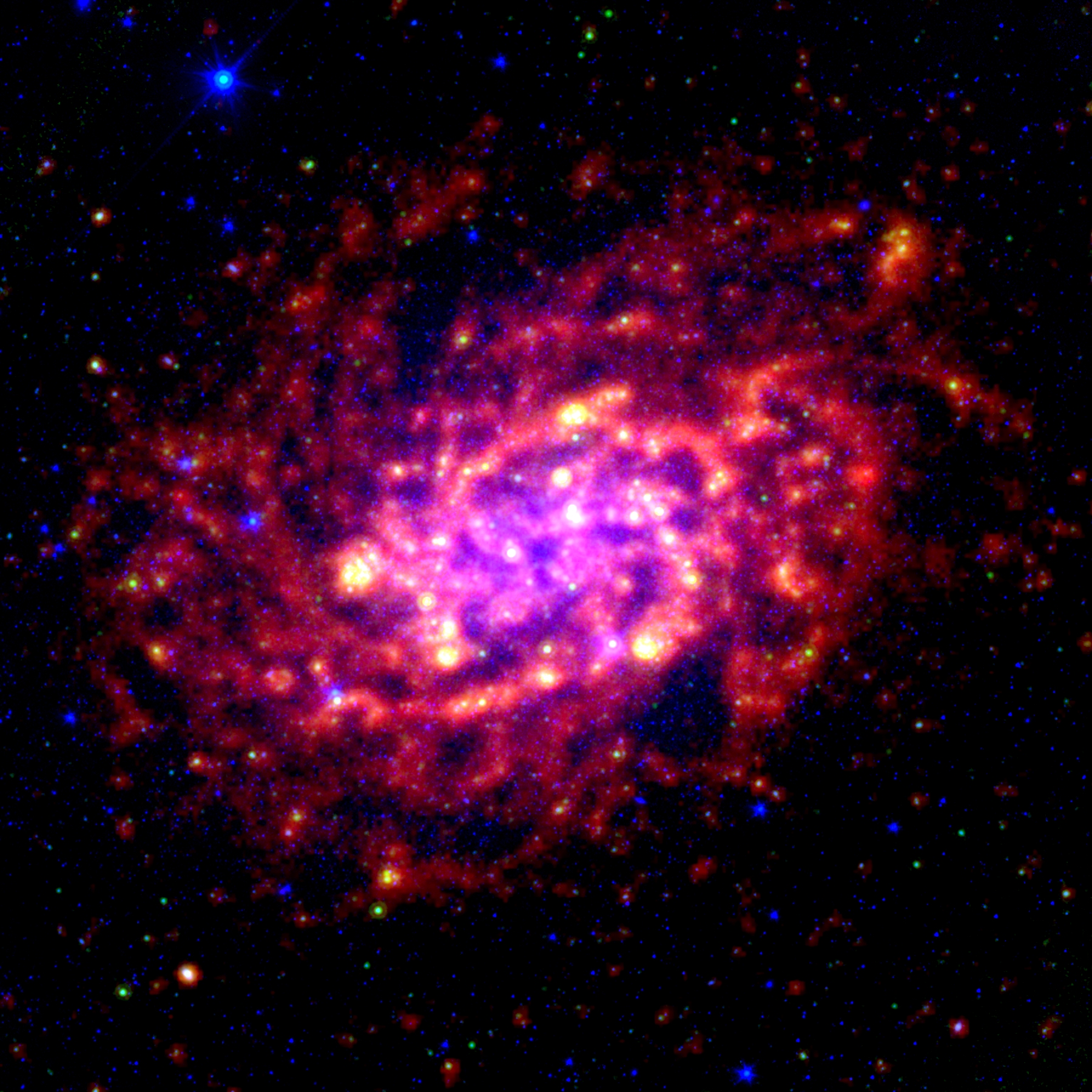
NGC 300
Green: Spitzer 24 micron mid-infrared image of hot interstellar dust ( FITS image)
Blue: Spitzer 3.6 micron near-infrared image of older stars ( FITS image)
NGC 300 is very much like M33 above. This is another spiral galaxy with no bulge and very filamentary (or flocculent) spiral structure. The star formation, as traced by the hot dust, is found in knot-like regions inside the filaments. Star formation in the center of the galaxy is relatively weak compared to many regions in the filaments.
I created all three of these images using data from the Spitzer and Herschel arcives. I will be using the images for a research project on heating in the interstellar medium.
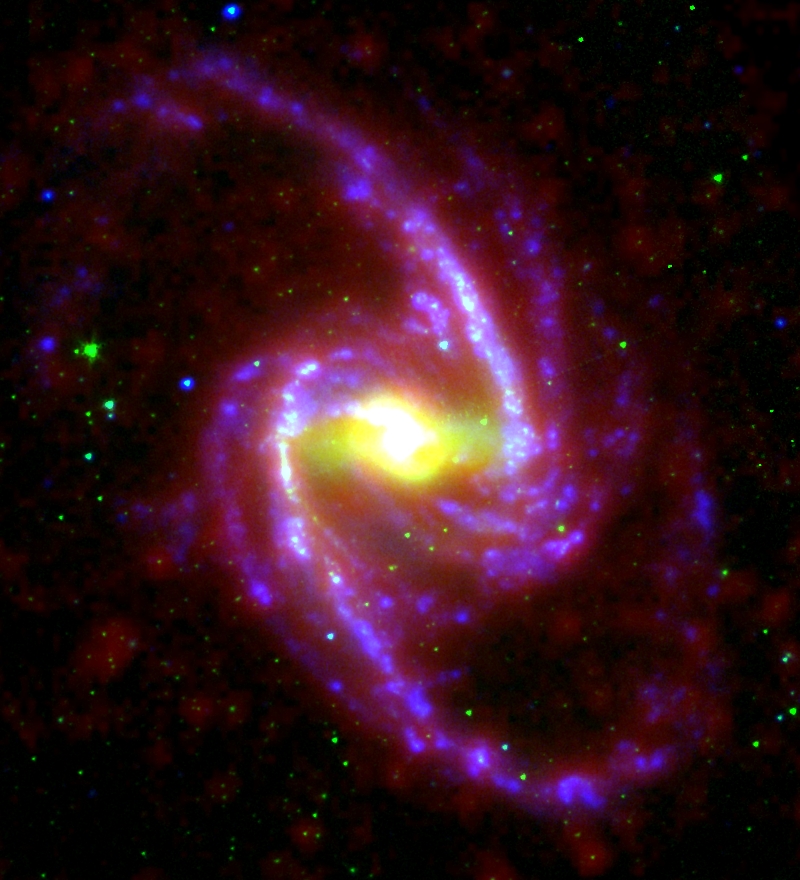
NGC 1365
Green: Spitzer 3.6 micron near-infrared image of older stars ( FITS image)
Blue: GALEX 2267 Angstrom ultraviolet image of young stars ( FITS image)
NGC 1365 is a notable barred galaxy in the Fornax Cluster. Its nucleus hosts a dust-obscured starburst that is so bright at infrared wavelengths that this galaxy is classified as a luminous infrared galaxy. The nucleus is the dominant source of mid-infrared emission, while the spiral arms are more visible in ultraviolet and far-infrared emission.
I created the 3.6 and 250 micron images for a science project that I am working on. The ultraviolet image is from the GALEX archive.
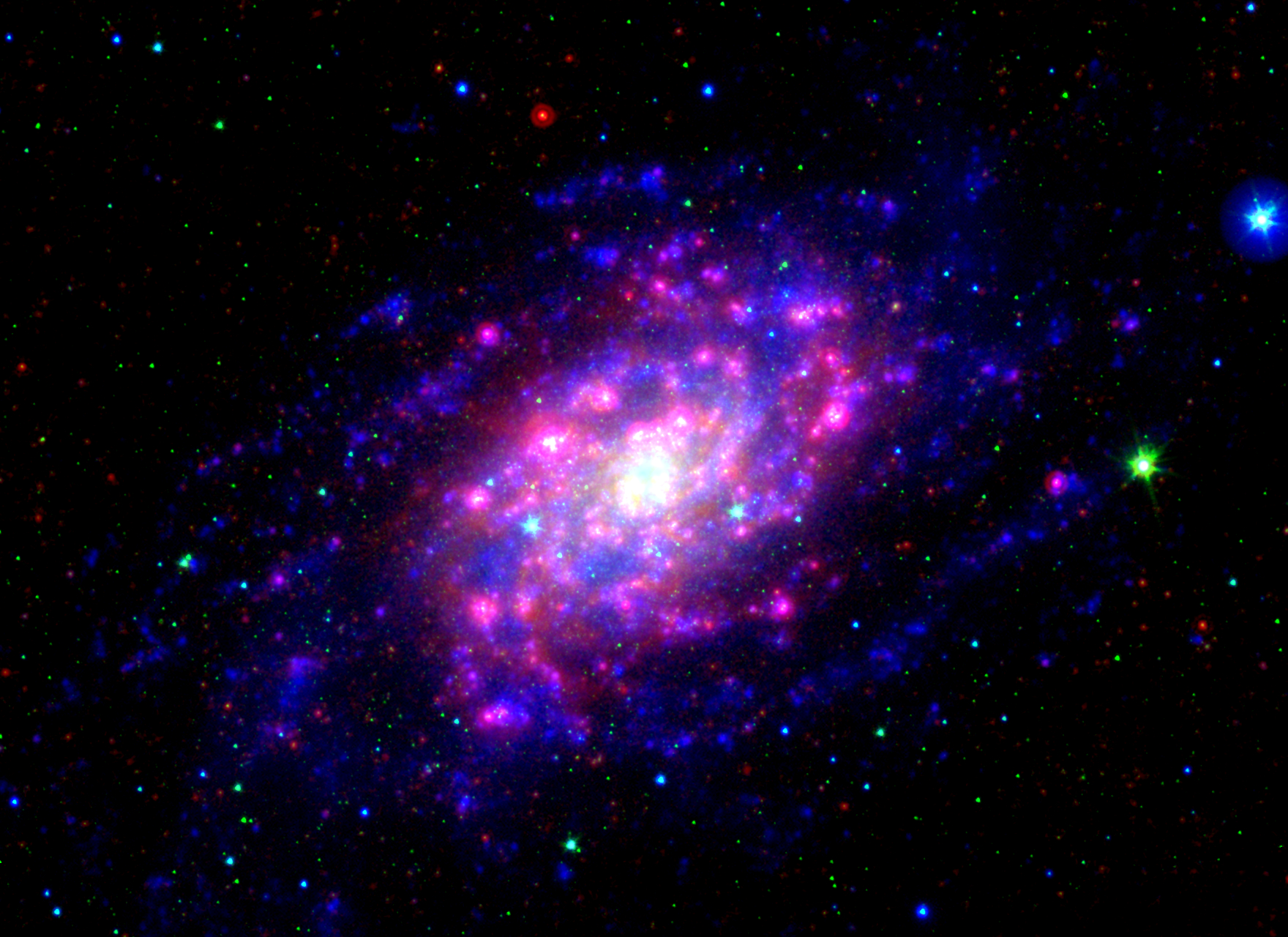

NGC 2403
Green: Spitzer 3.6 micron near-infrared image of older stars ( FITS image)
Blue: GALEX 2267 Angstrom ultraviolet image of young stars ( FITS image)
NGC 2403 is another flocculent spiral galaxy with no central bulge that is very similar to M33. I particularly like this galaxy because the site with the strongest star formation and strongest infrared emission is located outside the center of the galaxy and the location with the greatest number of old stars, whereas in many other galaxies, the strongest star formation or the brightest infrared source is in the center. Because of the unusual characteristics of NGC 2403, I have been able to determine whether various phenomena (for example, how interstellar dust is heated) are actually related to star formation or radial effects within galaxies.
I created the 3.6 micron image for an upcoming paper and published the 24 micron image in another paper (Bendo et al., 2012, MNRAS, 423, 197). The ultraviolet image is from the GALEX archive.
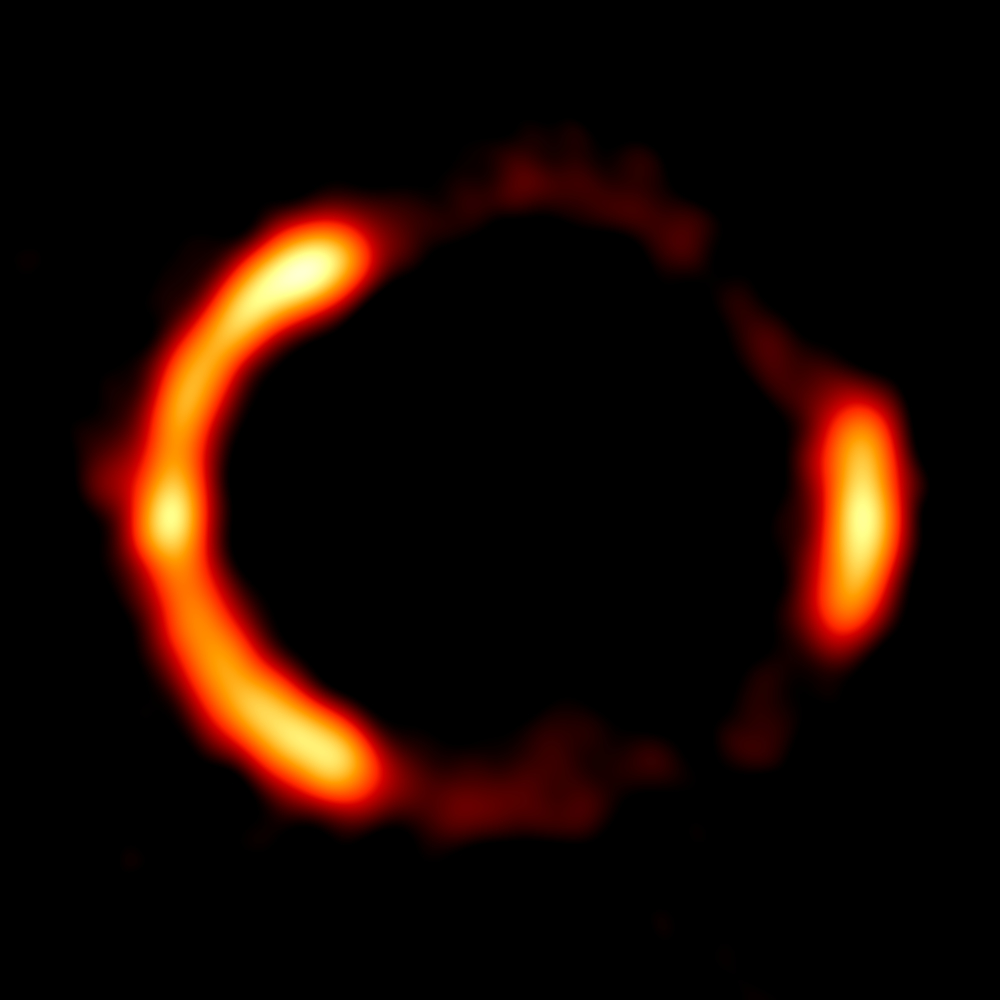
SDP.81
SDP.81 is a gravitational lens where a nearby galaxy (not seen in this image) gravitationally distorts the light from another galaxy behind it, producing a circle of light. The submillimeter radiation imaged here originates from warm interstellar dust.
I created this ALMA image while assisting a couple of other people with a potential project, but when I had finished, we all found out that the data had been published. ALMA released an image at a different frequency that shows more detail, but I still like this image.
Extragalactic Fields
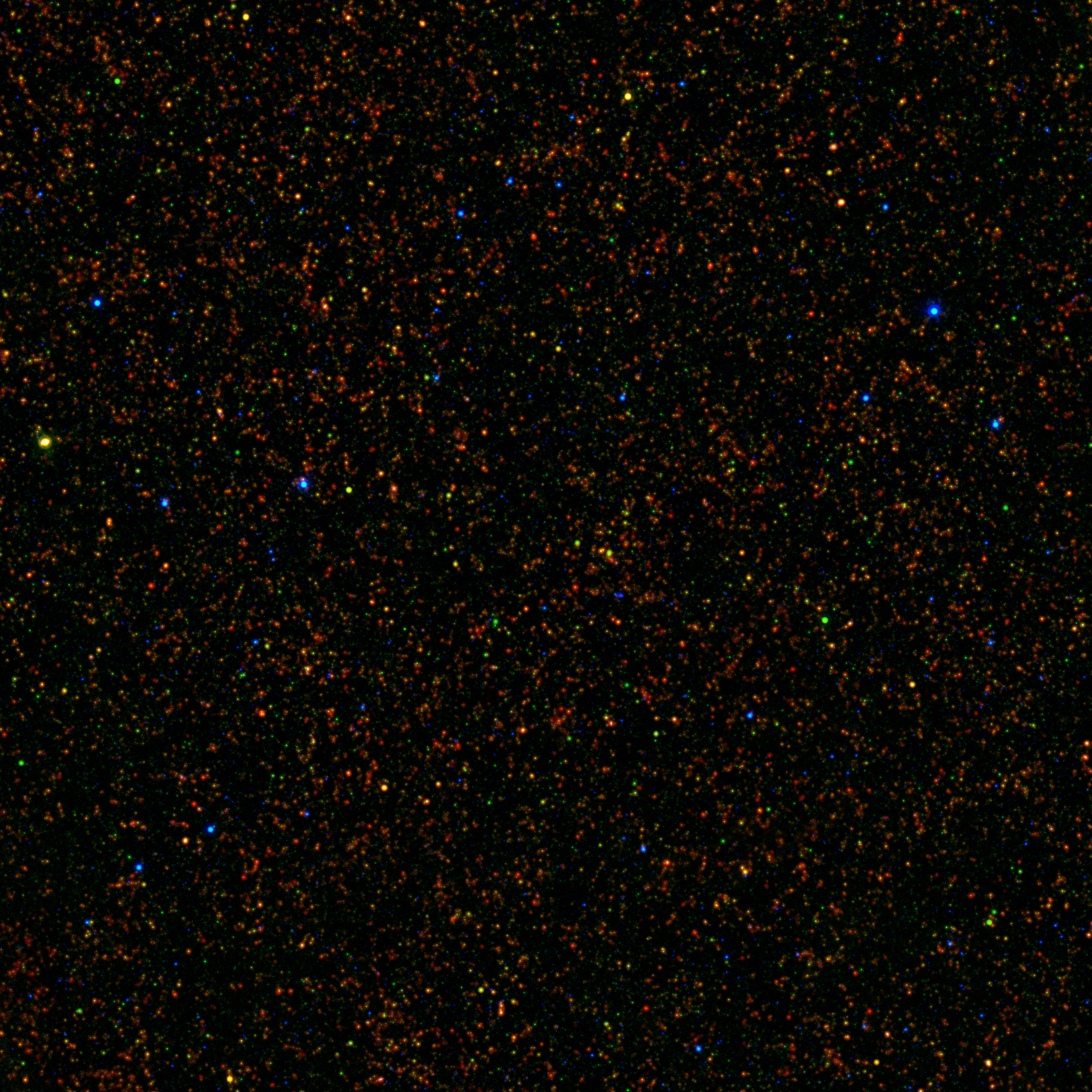
COSMOS field
Green: Spitzer 24 micron mid-infrared image of hot dust ( FITS image)
Blue: Spitzer 3.6 micron near-infrared image of old stars ( FITS image)
The Cosmological Evolution Survey (COSMOS) field is one of several fields in the sky that is relatively devoid of nearby stars, nebulae, or nearby galaxies and is therefore a good place to search for more distant galaxies. The bright blue and cyan sources in this image are mostly stars, but the green, red, and yellow objects are all galaxies.
I created all of the FITS images using data from the Spitzer and Herschel archives. The 250 micron FITS image was smoothed to produce this image; the actual 250 micron FITS image is more grainy.